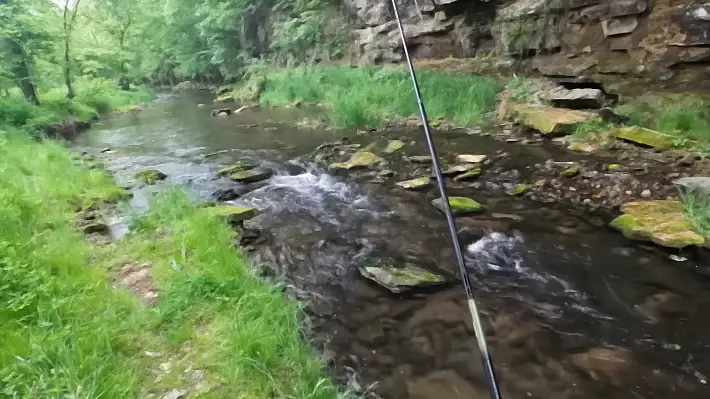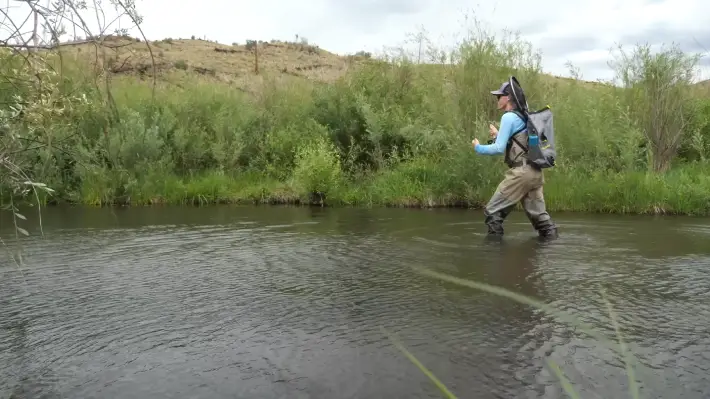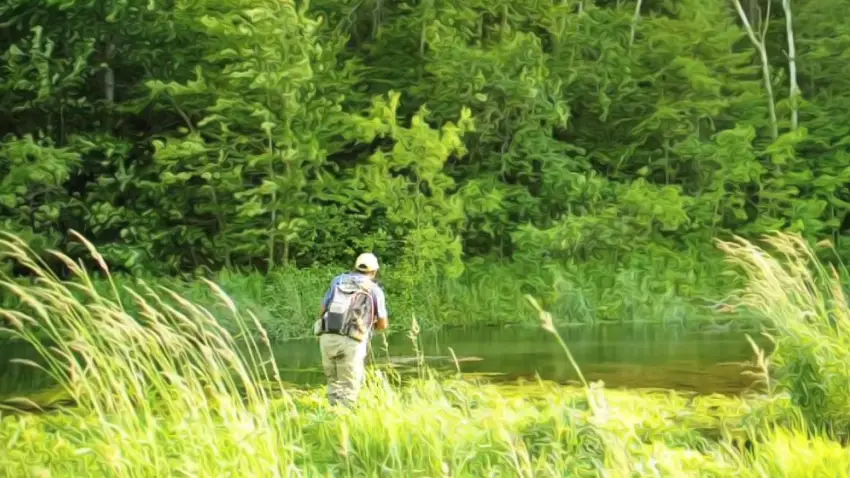Key Takeaways:
- There are lots of great fly fishing spots in Wisconsin, such as the Bois Brule, Namekagon River and Rush River.
- Spring and early summer are the best times to catch trout and steelhead in Wisconsin, while late summer and early fall are the best for the Driftless Region.
- You can target trout (brown, rainbow, and brook), steelhead, smallmouth and largemouth bass, walleye, northern pike, musky, and salmon.
- It’s essential to follow Wisconsin’s fishing regulations, which also apply to fly fishing.
- Regulations may change over time, so staying informed about the latest rules and checking for regional exceptions is crucial for responsible fly fishing.
List of the Top 16 Places for Fly Fishing in Wisconsin

Below are Wisconsin’s top 16 fly fishing destinations, each offering its unique charm and angling opportunities.
- Bois Brule River
- Rush River
- Pine River
- Kinnickinnic River
- Kickapoo River West Fork
- Namekagon River
- Wolf River
- Peshtigo River
- Black Earth Creek
- Pike River
- Castle Rock Creek
- Root River
- Timber Coulee
- Lower Wisconsin River
- Big Green River
- St. Croix Headwaters
Now, explore each of these 16 fly fishing locations in Wisconsin and discover their unique specialties and angling opportunities.
1. Bois Brule River
- Located in Northeastern Wisconsin, spanning 43.9 miles through Douglas County.
- Known for rainbow trout, brown trout, steelhead, and salmon.
- Use effective flies such as the “Burnt” Wulff and Caddis Nymphs when fishing here for trout or Egg Flies for salmon and steelhead.
2. Rush River
- Flows through St. Croix County in western Wisconsin, spanning 49.8 miles.
- Favorite for brown and brook trout, especially during the warmer summer months.
- Rush River Wildlife Area between Baldwin and Martell is the best place to enter. Consider using flies like the Black X Caddis during the spring’s major hatch.
3. Pine River
- A designated wild river in Waushara County, central Wisconsin.
- Contains brown trout and brook, as well as smallmouth bass.
- For successful fishing, consider using a Woolly Bugger or Midge pattern. During mid-summer, Mosquito flies (size 16-18) are effective.
4. Kinnickinnic River
- Located in northwestern Wisconsin, a 22-mile-long (35 km) river in the United States.
- Known for its self-sustaining trout population and beautiful pastures.
- Access is relatively easy, and you’ll find numerous entry points along County Road FF heading towards Minneapolis from River Falls.
5. Kickapoo River West Fork
- 101 miles (163 km) long river, located in northwestern Wisconsin in the United States.
- Sizable brown trout are available for catch-and-release fishing; casting along banks is recommended.
- Trico hatches in late summer, Little Black Caddis hatches in early spring, Blue Winged Olive flies, and imitations are effective.
6. Namekagon River
- Located in northern Wisconsin and is a tributary of the St. Croix River.
- Smallmouth bass and musky in a serene angling environment surrounded by forests.
- Canoe-friendly, with Woolly Buggers and Clouser Minnows as effective fly choices.
7. Wolf River
- Located in northeastern Wisconsin, a tributary of the Fox River in the Great Lakes region of the United States.
- Trout and salmon fishing in varying conditions, from calm pools to rapid sections.
- Try egg flies and Hexagenia Limbata imitations during the “Hex” hatch.
8. Peshtigo River
- Situated in northeastern Wisconsin and stretches for 136 miles, ending at Green Bay.
- Offers a diverse range of fish species, including smallmouth bass, musky, walleye, and northern pike.
- Requires the use of large streamers and topwater flies.
9. Black Earth Creek
- Located west of Madison, Wisconsin, and is renowned for its Class 1 trout stream.
- A well-known spring-fed creek, sustains a healthy population of brown trout due to its cold, clear water.
- Consider using popular trout fly patterns such as the Blue-Winged Olive or Scud to maximize your chances of success.
10. Pike River
- One of Wisconsin’s three wild rivers, it drains into Lake Michigan
- Famous for lake-run salmon, steelhead, and brown trout.
- Recommended fly choices include X-Legs Variations and Beadhead Hares Ear Soft Hackle.
11. Castle Rock Creek
- Located east of Fennimore and flows into the Blue River.
- Offers picturesque fly fishing in pastures and fields.
- Stealth is key due to overgrown brush, with recommended flies including Blue-Winged Olives and streamers.
12. Root River
- A 43.7-mile-long river, located in southeastern Wisconsin, United States, flows into Lake Michigan at the city of Racine.
- Popular for steelhead and trout, open casting lanes and deep pools for easy fishing.
- Lincoln and Colonial Parks are accessible fishing points, wading is recommended, and effective flies include egg flies and Stoneflies.
13. Timber Coulee
- Located just outside of Coon Valley, approximately 45 minutes east of La Crosse.
- Known for big brown trout, but casting can be a challenge due to overgrown brush and vegetation.
- Summer is best for fly fishing with hopper flies; rainbows are also abundant, and a dry-dropper with a Beadhead Prince Nymph works too.
14. Lower Wisconsin River
- Flows south from Wisconsin-Michigan border to Mississippi, covering 430 miles.
- Warm water for smallmouth bass, pike, and other species, making it ideal for river fishing enthusiasts.
- Most productive between May and October, 3M Minnows and Boogle Bugs catch smallmouth bass and Jared’s Outlaw streamers catch pike.
15. Big Green River
- Situated just south of Wauzeka, Wisconsin, and serves as a creek tributary of the Wisconsin River.
- Offers challenging fly fishing experiences with wild brown trout as the main target.
- Effective flies for fishing in the Big Green River include Blue-Winged Olives and small terrestrial patterns.
16. St. Croix Headwaters
- St. Croix River’s headwaters are in Wisconsin, on the south shore of Upper St. Croix Lake.
- Serene setting with a mix of fish species, including walleye, sauger, and northern pike.
- For successful angling, use Blue Winged Olives or Midges, which are known to produce excellent results.
When is the optimal season for fly fishing in Wisconsin?

The ideal season for fly fishing in Wisconsin varies depending on the location. Spring and early summer, from April to June, are excellent times for fly fishing in rivers like the Bois Brule, Rush River, and Namekagon River. These months are ideal for targeting trout and steelhead.
Late summer to early fall, from July to September, is great for fishing the Driftless Region streams like Kinnickinnic River, Kickapoo River West Fork, and Timber Coulee Creek.
The fall season, particularly October, is a prime time for salmon and steelhead in rivers such as the Bois Brule and Wolf River.
Regarding warm water fisheries like the Lower Wisconsin River, late spring through early autumn provides great fishing opportunities.
What fish species can you target when fly fishing in Wisconsin?
If you’re planning to fly fish in Wisconsin’s rivers and streams, you’ll have plenty of fish species to target. You can try your luck at catching brown trout, rainbow trout, brook trout, and steelhead.
The state is also home to smallmouth bass, largemouth bass, northern pike, walleye, musky, and salmon, which you can catch in different spots.
What are the fishing rules and regulations in Wisconsin?
In Wisconsin, fly fishing is governed by the same set of regulations as other fishing methods. Here are the key regulations that apply to fly fishing in Wisconsin:
Fishing Licenses:
- If you’re a resident aged 16 or older, you must possess a fishing license to fly fish in state waters.
- Non-residents aged 16 and older require a non-resident fishing license.
- Special licenses are available for various groups, including senior citizens, disabled individuals, and veterans.
Angling Methods and Lures:
- As a fly angler, you’ll need to adhere to restrictions regarding the number of hooks, baits, and lures used during fishing.
- Regulations prevent leaving fishing lines unattended, except when using licensed setlines or bank poles.
- Prohibitions exist on fishing with unmanned aircraft systems (drones) and employing jug fishing in all state waters.
Bait Usage:
- Releasing unused bait into Wisconsin’s lakes, ponds, rivers, and streams is illegal.
- Anglers are not allowed to possess live crayfish while fly fishing in state waters.
- Gamefish cannot be used as bait unless they meet specific size restrictions and are included in the angler’s daily bag limit for that species.
Seasons, Bag Limits, Length Limits, and Possession Limits:
- It is crucial to adhere to the closed season for various fish species and refrain from fly fishing during those periods.
- Seasonal regulations govern the fly fishing of specific species and dictate bag limits, length limits, and possession limits.
- These regulations are put in place to conserve fish populations and maintain the balance of aquatic ecosystems.
Illegal Fishing Activities:
- A list of illegal fishing activities, including the movement of live fish away from water, loaning or borrowing another person’s license, and using prohibited fishing techniques.
- Activities like snagging fish, foul-hooking, and keeping fish not hooked in the mouth are also prohibited.
Tagging and Registration:
- Anglers intending to harvest lake sturgeon using fly fishing methods must purchase an inland tag or a WI/MI boundary water tag.
- Validation of the tag is necessary when keeping a harvested fish.
- Fish must be registered at designated registration stations no later than 6 pm the day after they are caught.
Regulations may change, so you need to stay updated and check for the latest rules and any specific regional exceptions before you go fly fishing in Wisconsin.

